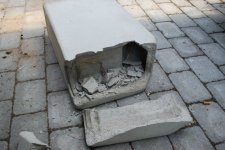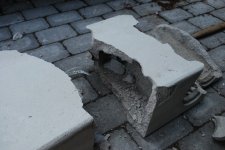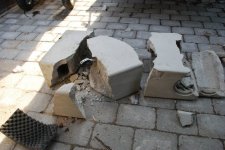planet10 said:
Closed end is 3.2? Then it is not a TQWT, but a (not quite) 2:1 TL.
As to how it works, i'd have modeled it with MJK tables at least before building. I'm guessing you used Classic techniques which sometimes work, sometimes not.
dave
I did simulate it before building. I used an old mjk mathcad sheet: "Driver in open ended Transmission line - Acoustic and electrical response 12/20/03"
Just for the record
An externally hosted image should be here but it was not working when we last tested it.
The loudspeaker (yes just one at the moment) now playing music in my living room and i'm quite pleased with the sound. The CHR-70 really lives up to be a true fullrange driver. It's actually the first fullrange driver I have tested (not very many but still) without need for a supertweeter. I'm surprised over the bass response in this cabinet. Hard to belive the little driver delivers low frequencys that you can actually feel.
My dilemma now is if i'm gonna build one more, to complete the pair or if i'm gonna try a different design. This one was after all just a prototype to test the concrete-polystyrene-thinner method.
I would think that if you are satisfied with the sound you might want to forge ahead with building a pair based on your experience and what you learned here. It seems that bjorno's suggestion of EPS cement and mine of delimonine to melt the polystyrene could be implemented for a prototype pair.
Delimonine is also called orange oil or citrus oil and should be available at chemical supply companies. I've seen a product called OrangeSolv which is 93% delimonine and ORANGE-SOL which also has a high delimonine content. 5 gallons is about $100 in the US.
Edit: after reading what EPS cement is I don't think it would work too well as it contains expanded polystyrene which would be degraded by any solvent used to remove your polystyrene form.
Delimonine is also called orange oil or citrus oil and should be available at chemical supply companies. I've seen a product called OrangeSolv which is 93% delimonine and ORANGE-SOL which also has a high delimonine content. 5 gallons is about $100 in the US.
Edit: after reading what EPS cement is I don't think it would work too well as it contains expanded polystyrene which would be degraded by any solvent used to remove your polystyrene form.
H@kan,
Very interesting project and a nice adaptation on the lost foam process.
Lost Foam seems to be popular for metal castings and even model planes.
Now you proved one can use it for speakers too!
http://www.buildyouridea.com/foundry/lost_foam_howto/lost_foam_howto.html
http://www.rcgroups.com/forums/showthread.php?t=188980
Prasad
Very interesting project and a nice adaptation on the lost foam process.
Lost Foam seems to be popular for metal castings and even model planes.
Now you proved one can use it for speakers too!
http://www.buildyouridea.com/foundry/lost_foam_howto/lost_foam_howto.html
http://www.rcgroups.com/forums/showthread.php?t=188980
Prasad
h@kan said:I used an old mjk mathcad sheet
An externally hosted image should be here but it was not working when we last tested it.
The loudspeaker (yes just one at the moment) now playing
It is good that you have that. You don't see many end-loaded TLs designed with MJK sheets. Even just a bit of driver offset can have a positive effect on the amount of ripple in the passband.
dave
jackfish said:I would think that if you are satisfied with the sound you might want to forge ahead with building a pair based on your experience and what you learned here. It seems that bjorno's suggestion of EPS cement and mine of delimonine to melt the polystyrene could be implemented for a prototype pair.
Delimonine is also called orange oil or citrus oil and should be available at chemical supply companies. I've seen a product called OrangeSolv which is 93% delimonine and ORANGE-SOL which also has a high delimonine content. 5 gallons is about $100 in the US.
Edit: after reading what EPS cement is I don't think it would work too well as it contains expanded polystyrene which would be degraded by any solvent used to remove your polystyrene form.
If I can find any high concentration d-limonene product here in sweden I will definitely try that out because the thinner part is the only part that was not fun at all. Cutting polystyrene is a joy
If it's $100/gallon it's pretty much the same price as toulen/thinner, I would pay 4 times the price of thinner just to avoid the fumes.
No I don't think EPS would be a good idea but my plan is to mixing the concrete with leca balls to reduce some weight.
quadtech said:H@kan,
Very interesting project and a nice adaptation on the lost foam process.
Lost Foam seems to be popular for metal castings and even model planes.
Now you proved one can use it for speakers too!
http://www.buildyouridea.com/foundry/lost_foam_howto/lost_foam_howto.html
http://www.rcgroups.com/forums/showthread.php?t=188980
Prasad
I had no idea of that this method had a Trivial name!
With this info i'm sure I can google for som useful tips & trix.
Thank you!
I decided to build another one since, no offense to mono lovers, I think stereo is more 2009
The second polystyrene form only took me 45 minutes to build. It's amazing how fast things go the second time you do it. I think the first one took me 3-4 hours
If it's $100/gallon it's pretty much the same price as toulen/thinner, I would pay 4 times the price of thinner just to avoid the fumes.
You should be able to find food grade d-limonene which is about 95%. I can get it here in the US for about $35 a gallon.
This is what happens when using a 25 mm round port in the terminus. The length of the port is 25mm.
I measure flush the port and in center.
I think this will be the final design.
The helmholtz resonator is closed because I did'nt manage to tame the ripple with it... well I did but then it also reduced the frequencies under 70 Hz.
I will test citrus oil to get rid of the polystyrene on the next speaker. I have found the product here in sweden for < $50/5 liters
Thank for the info jackfish! I will post the results later...
An externally hosted image should be here but it was not working when we last tested it.
I measure flush the port and in center.
I think this will be the final design.
The helmholtz resonator is closed because I did'nt manage to tame the ripple with it... well I did but then it also reduced the frequencies under 70 Hz.
I will test citrus oil to get rid of the polystyrene on the next speaker. I have found the product here in sweden for < $50/5 liters
Thank for the info jackfish! I will post the results later...
Yesterday I was cleaning up behind the garage and find this, one year old, speaker  I didn't manage to get hold of any high concentration delimonine so I didn't tried that out. There was never a #2 of this speaker.
I didn't manage to get hold of any high concentration delimonine so I didn't tried that out. There was never a #2 of this speaker.
Before I threw it away I crashed it with a sledge hammer to see how good I had managed to get the EPS out.
The result, shown in the pictures, was quite good. Some fragment are still left but my guess is that 99% is gone.
Regards Håkan
Before I threw it away I crashed it with a sledge hammer to see how good I had managed to get the EPS out.
The result, shown in the pictures, was quite good. Some fragment are still left but my guess is that 99% is gone.
Regards Håkan
Attachments
- Status
- This old topic is closed. If you want to reopen this topic, contact a moderator using the "Report Post" button.
- Home
- Loudspeakers
- Full Range
- TQWT Concrete cabinet attempt, building thread.


